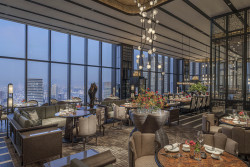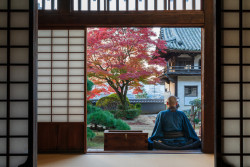
August 5, 2010
The Birth of Chinese Civilization
An extensive exhibition at the Tokyo National Museum leads straight to the souvenir shop
By Metropolis
Originally published on metropolis.co.jp on August 2010

Three-colored vase with two dragon handles, glazed pottery, height 41.2cm, Tang dynasty, 7th-8th century. Zhengzhou Municipal Institute of Cultural Relics and Archaeology

Mythical animal, bronze with inlaid turquoise, height 48cm. spring and autumn period, 6th-5th century BC. Henan Provincial Institute of Cultural Relics and Archaeology

Plaque with animal design, bronze with inlaid turquoise, length 16.5cm, Xia period, 17th - 16th century BC. Luoyang Museum
I wonder if I’ll ever go to an exhibition on Chinese history that tells me something big and new. The title of this show certainly got my hopes up. I thought that at last I might encounter some startling new theory—supported by groundbreaking archaeological evidence—to explain one of the seminal moments in human history: the founding of a potent civilization in the Yellow River valley that would go on to shape and define so much of Asian culture.
Alas, “The Birth of Chinese Civilization” is not that show. Instead of ruffling feathers with daring new ideas of the kind you occasionally come across in magazines like National Geographic (my favorite is the one about Chinese civilization getting kick-started by an irruption of red-haired foreigners from the West), this exhibition offers the sort of generic information that’s equally applicable to other civilizations. Section one, “The Birth of Dynasties,” informs us that “organized governments which centralized both knowledge and power” were crucial to the development of Chinese power. You don’t say!
To be fair to the curators, the evidence used to illustrate such truisms is lovingly presented, with items like the turquoise inlaid Plaque with animal design (Xia dynasty, 17th–16th century BC) magically spotlighted. However, this little piece, with its stylized view of an animal, as well as cooking vessels, wine warmers, bells and other decorative pieces, offer little insight about the nuts and bolts of political centralization. Instead, I was put in mind of a selection of pleasant wedding gifts, even if the impressive Jade shroud sewn with gold wire (Western Han dynasty, 1st century BC) clearly had more to do with funeral rites.
Section two, “The Birth of Craftsmanship,” is dedicated to a second great platitude: that a “key characteristic” of Chinese civilization was the emergence of “techniques for producing life-enriching tools and utensils.” Indeed, this is a “key characteristic” of every civilization!
Here we get a wide range of items that invite us to imagine the daily life of the ancient Chinese. Occasionally, this throws an interesting tidbit, like the crude earthenware Figure preparing animal carcass (Han dynasty, 1st century BC-2nd century AD), which shows us how animals were flayed. The item depicts a man blowing into a small hole cut in a dead pig to help loosen the skin from the flesh—fascinating in its small way.
Even this odd item, with its delicious hint of pork, plays to the exhibition’s central refrain: the suggestion that ancient China, despite a few technological drawbacks, was essentially on the same track as our cozy, modern, materialist society. This is Chinese history as unchallenging, consumer-friendly commodity for museum-goers on their way through the exhibition to the well-stocked souvenir shop beyond, helped along by section three, “The Birth of Artistic Beauty.”
While the show may be at most people’s comfort levels, for history buffs like me it’s not enough. The known facts suggest that Chinese civilization grew out of a struggle to survive repeated external threats, punctuated by calmer periods of internal stagnation. Even China’s recent ascendancy fits into this pattern, having its roots in the enormous stimulus towards unity and modernization created by the Japanese invasion of 1937.
Unlike European civilization, which seems always to have been driven by an internal Alexandrian urge to explore, expand, trade and proselytize, Chinese civilization got much of its impetus and energy from reacting to threats from without. When these were in abeyance, the Chinese seem to have been happy to create the kind of pretty artifacts on display here—most of which were apparently dug up after being lost, broken, or buried in the periods of chaos that came along with alarming regularity.
Tokyo National Museum
The Birth of Chinese Civilization. Various media. Until Sep 5, free (MS and under)/¥900 (HS)/¥1,200 (univ)/¥1,500 (adult). 13-9 Ueno Park, Taito-ku. Tel: 03-3822-1111. Open Tue-Sun 9:30am-5pm, closed Mon. Nearest stn: Ueno. www.tnm.jp







